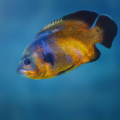Are you looking for a delightful addition to your aquarium? The Black Oscar Fish is all you need and more. This stunning freshwater fish has a striking dark appearance and color variations that significantly differ from other species.

Introduction
Oscar fish, also called the Oscar Cichild, is a popular tropical freshwater fish from the Amazon River in South America. They are generally considered the most intelligent and strong-willed aquarium hobby fish with a beautiful memory. They are one of the few aquarium fishes that can be trained to recognize their owner and perform tricks.
They are large-sized with a voracious appetite, eating anything that can fit into their mouths. There are lots of color variations of the Oscar fish, including the Black Oscar, Blue Oscar, Lemon Oscar and Tiger Oscar, to name a few.
The Black Oscar fish is a unique species and one of the rarest morphs of the Oscar fish family. It is quite stunning, with colorations that significantly differ from any other.
Quick Sidenote: Do you want to watch this article instead of reading it? Checkout the highlight video below from our YouTube Channel (Or read the more detailed article below), be sure to Subscribe For More Great Fishkeeping Content:
Appearance and Characteristics

The Black Oscar Fish’s appearance is unique and different from other Oscar fish. They possess the following characteristics and traits.
Color
They have a predominantly black body, which may feature shades of grey. Unlike other fish in the Oscar family like the Tiger Oscar with vibrant orange markings, Black Oscars lack these vibrant colors, often presenting with a mottled pattern with black and grey variations.
Size
When it comes to the Oscar fish size, they can grow to a significant size, usually reaching lengths of 12 to 14 inches (30-36 cm). Their large size makes them best suited for larger aquarium tanks with ample space and suitable conditions for their growth.
Unique Markings

A notable feature of Black Oscars is the presence of ocelli (eye spots), large black spots surrounded by a bright orange ring near the base of the tail fin. These ocelli play a protective role by confusing potential predators, misdirecting their attention away from the fish’s head.
Although they exhibit primarily black patterns, some Black Oscars may possess other unique fish markings, like lighter stripes around their midsection. However, these stripes are not as unique as those in other Oscar varieties.
Traits
As I mentioned earlier, Oscars are intelligent creatures and the Black Oscar variety is no different from its peers. They are pretty hard-headed and known to love being the center of attention.
They are known for recognizing their owners as soon as they come into a room and respond by wagging their tails, just like a puppy.
They can get aggressive, often attacking other fish in the aquarium and, sometimes their reflection. Another fun trait of Black Oscars is that they love to jump; it’s best to get an aquarium with a tight-fitting hood.
Natural Habitat
These stunning fish originate from freshwater environments in South America, particularly the river basins of the Amazon, Orinoco and Paraná.
The Black Oscar’s habitat consists of various aquatic ecosystems, including rivers, swamps and ponds. Their natural environment is slow-moving waters with ample cover and warm temperatures.
Oscar Fish’s wild and aggressive behavior originates from their natural habitat and the need to establish territories, especially during breeding. These behaviors are essential for their survival in the wild and protecting their eggs from potential threats.
Tank Setup and Requirements

Black Oscar’s tank setup is quite similar to other Oscar species. Due to their size and traits, sticking to their specific living requirements is important. Here are some of the most important things to consider when setting up their tanks:
Tank Size
Black Oscar fish are typically large-sized, growing up to 14 inches. This begs for a large fish tank with ample space for their active behaviors and general survival. Providing a tank your fish can grow into and thrive in is important.
The ideal tank size should be nothing less than 90 gallons per fish. You can aim for a 150 to 200-gallon tank if possible. I’d suggest this large tank size because you don’t want to stress your Oscar out by having a small aquarium, especially is setting up a community tank.
Water Parameters
Figuring out the aquarium requirements for your Oscar is pretty straightforward once you understand their natural habitat. Your fish requires optimum temperatures around 74°F – 81°F.
Try to maintain an average temperature of 78 degrees and avoid adjusting the heater excessively. The water pH should be kept between 6 and 8. Nitrites should always be 0, and Nitrates should be as close to 0ppm as possible.
Filtration System
To keep the Oscar fish’s environment in the best conditions, including a heavy-duty filtration system is important. Filtration is an important part of keeping your tank clean. I suggest you have one large filter or at least two large canister filters.
Diet and Nutrition
Now that we’ve discussed what their tank should look like, it’s time to discuss what to feed your fish.
For a species with an insatiable appetite, you might conclude that your Black Oscar’s diet should include a wide variety of food groups; you’re not wrong!
They are known for eating almost anything in their tank, so it’s important to provide them with meals with high nutrition and a balanced diet.
When feeding an Oscar fish, you should consider live foods and feeder fish like goldfish, crickets and mealworms.
Most aquarists, however, stick with pellets and occasionally feed live fish. Frozen foods like beef hearts, krill and bloodworms can also be considered occasional treats.
For more on feeding your aquatic pets check out The Ultimate Guide to Fish Food: Pros and Cons & Best Choices!
Behavior and Temperament
Oscars are known to have unique behavioral patterns and temperaments. They are semi-aggressive and territorial fish that establish dominance within their environment.
Black Oscars’ behavior is no different; they often get aggressive when breeding but can coexist peacefully if introduced at a young age and provided with hiding spots.
Oscar fish’s temperament is generally cool, but they become more aggressive when defending their nesting sites during breeding season. They may also exhibit fin-nipping and chasing behaviors towards other fish.
Their semi-aggressive behavior makes it important to choose appropriate tank mates if you want a community tank. This is where fish compatibility comes into play.
Potential tank mates should also be large cichlids from South America. These fish are not recommended for community tanks with mall peaceful fish as they could bully and eat them.
Breeding Black Oscar Fish

Breeding Black Oscars is not impossible but slightly more difficult than breeding other freshwater varieties.
The difficult part is finding Oscar pairs that actually like each other enough to spawn together. For a successful Oscar fish mating process, choosing Oscar pairs at least two years old is best.
This video has been very helpful in identifying the sex of Oscar fish, I highly recommend it:
To induce spawning, keep the Oscar pair in clean water. Water can be kept clean by changing 20-30% of the water twice every week and siphoning the gravel. Also, feed the pair a varied diet of both live and frozen foods.
Mating begins when you notice a distinct change in swimming behavior; you may notice the pair slapping each other with their tails or chasing each other around the tank. The female typically produces eggs 2-3 days after mating, and the fish fry hatches from the eggs 72 hours after being laid.
To provide the best fish fry care, moving the eggs to a separate tank and leaving them to hatch is important.
When it’s closer to their hatching period, you can see the fry visibly moving inside their shells. For the first four days after they hatch, they consume their egg sack and rarely need feeding. On the fourth day, you should begin supplemental feeding.
Common Health Issues and Treatments
Black Oscar’s health is rarely affected by diseases because they are sturdy fish with strong immune systems.
Over the years, I’ve learned that diseases may result from the owner’s negligence or incorrect choices. With frequent water changes and installing a UV sterilizer in your tanks, fish disease prevention is straightforward.
Some of the most common diseases affecting Black Oscars include:
· Hole in the head: This manifests as small holes and sores on the head of the Oscar fish. Experts haven’t concluded on the exact cause of this disease, but the treatment option is simple. Adding metronidazole to the water helps with the sores.
· Fin and tail rot: This condition attacks the fish’s fins and may cause complete fin decay. You can treat this with over-the-counter antibiotics like tetracycline.
· Bloat: Oscars are prone to bloating. This mostly depends on their diet, and an effective treatment is to feed your pet soft pees to improve bowel movement.
An important part of maintaining your fish’s health is by closely monitoring their behaviors to catch any changes early. Oscar fish’s treatment options are accessible and easy to administer when these infections are caught at an early stage.
Lifespan and Growth

Regarding your Black Oscar’s lifespan, proper care and an ideal environment play the most important roles. These fish have the potential to live up to 20 years if provided with optimum conditions for their survival. On average, they are expected to live about 10 to 15 years.
Oscar fish growth rates are generally rapid, and they reach their full size within a year. This is why it is important to provide them with a large tank with enough space from the jump.
If you want to improve your pet Oscar fish’s longevity and lifespan, you must pay attention to their feeding habits, provide regular veterinary care and maintain stable tank conditions.
Tips for Keeping Black Oscar Fish Happy
Here are some practical Black Oscar care tips to keep your pet healthy and happy:
Tank Decoration
Black Oscars are active fish that love to hide and swim freely. To allow your pet to exhibit its natural behavior, providing plenty of hiding spots and decorations like rocks, large plants and driftwood is important. Also, incorporate a soft or sandy substrate to allow your Oscar to dig and explore.
Social Interactions
Keeping a happy Oscar fish has a lot to do with its environment and community. It’s important to keep them with suitable tank mates and provide ample space to prevent aggression.
Regular Tank Maintenance
A strict fish tank maintenance schedule is important for your pet’s health and longevity. Perform weekly water changes and maintain ideal water parameters.
Conclusion
Black Oscars are captivating and intelligent creatures that make every minute of owning a freshwater fish worth the experience.
They are exciting fish with unique personalities that are sure to keep you engaged. For pet owners developing an aquarium hobby, the Oscar fish, particularly the Black Oscar, is an important variety to consider.
If you are still unsure about the best-suited fish for you, this Black Oscar fish care conclusion is all you need to put you on the path of the exciting journey of owning this rare beauty!











